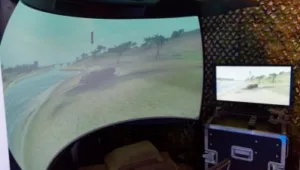Cobra Simulations specialiises in single channel immersive dome displays. They are based on the use of a COTS projector (around 80% of units can be used although the firm works closely with Optoma, Sony, Canon and Barco, although it has also used Digital Projection and JVC units for particular customers). The dome has a reflective curved mirror that reflects the image back onto the dome. The use of a mirror means that the quality is very, very close to that coming out of the lens and the company claims that only 3% of the light is lost at the mirror.
 Cobra showed the projector lens on the left shining on to the mirror (right) and back onto the dome. Image:Meko
Cobra showed the projector lens on the left shining on to the mirror (right) and back onto the dome. Image:Meko
At the show, the company was showing a 1.8m dome that has a 150º FOV horizontally and 66º vertically. The dome frame is now made of aluminium to reduce weight and the whole system can be put into a custom flight case that can be loaded into a Transit van. The company has a number of accreditations for simulation including for the Eurofighter and F35. Moving up in size, the company also has a 2.1m dome with 180º FOV horizontally and 80º vertically. The largest that has been made is a 4.3m version.
Because the projector is at the top of the dome, the bottom can be cut to fit a cut out around, for example, a set of driving controls or to allow feet and legs to be put below and behind the screen, which is especially useful when a vehicle is being simulated using physical controls.
Cobra highlighted that it has its own warping technology which needs an Nvidia GPU, but as it does not need a Quadro graphics card, low cost cards can be used. The warping is specially designed to ‘concentrate the pixels’ towards the edges of the display, where the geometry would usually mean that fewer pixels would be distributed over a larger area, reducing the effective resolution.
 Cobra showed how the user can be close to the screen and cutouts are possible to get even closer. Image:Meko
Cobra showed how the user can be close to the screen and cutouts are possible to get even closer. Image:Meko

